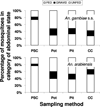Sampling outdoor, resting Anopheles gambiae and other mosquitoes (Diptera: Culicidae) in western Kenya with clay pots
- PMID: 17294916
- PMCID: PMC4106366
- DOI: 10.1603/0022-2585(2007)44[14:soraga]2.0.co;2
Sampling outdoor, resting Anopheles gambiae and other mosquitoes (Diptera: Culicidae) in western Kenya with clay pots
Abstract
Clay pots were analyzed as devices for sampling the outdoor resting fraction of Anopheles gambiae Giles (Diptera: Culicidae) and other mosquito species in a rural, western Kenya. Clay pots (Anopheles gambiae resting pots, herein AgREPOTs), outdoor pit shelters, indoor pyrethrum spray collections (PSC), and Colombian curtain exit traps were compared in collections done biweekly for nine intervals from April to June 2005 in 20 housing compounds. Of 10,517 mosquitoes sampled, 4,668 An. gambiae s.l. were sampled in total of which 63% were An. gambiae s.s. (46% female) and 37% were An. arabiensis (66% female). The clay pots were useful and practical for sampling both sexes of An. gambiae s.l. Additionally, 617 An. funestus (58% female) and 5,232 Culex spp. (males and females together) were collected. Temporal changes in abundance of An. gambiae s.l. were similarly revealed by all four sampling methods, indicating that the clay pots could be used as devices to quantify variation in mosquito population density. Dispersion patterns of the different species and sexes fit well the negative binomial distribution, indicating that the mosquitoes were aggregated in distribution. Aside from providing a useful sampling tool, the AgREPOT also may be useful as a delivery vehicle for insecticides or pathogens to males and females that enter and rest in them.
Figures





Similar articles
-
Evaluation of the performance of new sticky pots for outdoor resting malaria vector surveillance in western Kenya.Parasit Vectors. 2019 May 31;12(1):278. doi: 10.1186/s13071-019-3535-3. Parasit Vectors. 2019. PMID: 31151470 Free PMC article.
-
Indoor and outdoor malaria vector surveillance in western Kenya: implications for better understanding of residual transmission.Malar J. 2017 Nov 6;16(1):443. doi: 10.1186/s12936-017-2098-z. Malar J. 2017. PMID: 29110670 Free PMC article.
-
Effect of permethrin-impregnated nets on exiting behavior, blood feeding success, and time of feeding of malaria mosquitoes (Diptera: Culicidae) in western Kenya.J Med Entomol. 2001 Jul;38(4):531-6. doi: 10.1603/0022-2585-38.4.531. J Med Entomol. 2001. PMID: 11476333
-
The 'ghosts' that pester studies on learning in mosquitoes: guidelines to chase them off.Med Vet Entomol. 2006 Jun;20(2):157-65. doi: 10.1111/j.1365-2915.2006.00623.x. Med Vet Entomol. 2006. PMID: 16871700 Review.
-
Genetic control of mosquitoes.Am J Trop Med Hyg. 1972 Sep;21(5):764-71. doi: 10.4269/ajtmh.1972.21.764. Am J Trop Med Hyg. 1972. PMID: 4403788 Review. No abstract available.
Cited by
-
Impact of Environmental Modifications on the Ecology, Epidemiology, and Pathogenesis of Plasmodium falciparum and Plasmodium vivax Malaria in East Africa.Am J Trop Med Hyg. 2022 Oct 11;107(4_Suppl):5-13. doi: 10.4269/ajtmh.21-1254. Print 2022 Oct 11. Am J Trop Med Hyg. 2022. PMID: 36228918 Free PMC article.
-
An exploratory study of community factors relevant for participatory malaria control on Rusinga Island, western Kenya.Malar J. 2007 Apr 24;6:48. doi: 10.1186/1475-2875-6-48. Malar J. 2007. PMID: 17456231 Free PMC article.
-
Comparison of the CDC Backpack aspirator and the Prokopack aspirator for sampling indoor- and outdoor-resting mosquitoes in southern Tanzania.Parasit Vectors. 2011 Jun 30;4:124. doi: 10.1186/1756-3305-4-124. Parasit Vectors. 2011. PMID: 21718464 Free PMC article.
-
Optimization of odour-baited resting boxes for sampling malaria vector, Anopheles arabiensis Patton, in arid and highland areas of Africa.Parasit Vectors. 2010 Aug 19;3:75. doi: 10.1186/1756-3305-3-75. Parasit Vectors. 2010. PMID: 20723243 Free PMC article.
-
Factors affecting fungus-induced larval mortality in Anopheles gambiae and Anopheles stephensi.Malar J. 2010 Jan 19;9:22. doi: 10.1186/1475-2875-9-22. Malar J. 2010. PMID: 20085659 Free PMC article.
References
-
- Beier JC, Perkins PV, Onyango FK, Gargan TP, Oster CN, Whitmire RE, Koech DK, Roberts CR. Characterization of malaria transmission by Anopheles (Diptera: Culicidae) in western Kenya in preparation for malaria vaccine trials. J. Med. Entomol. 1990;27:570–577. - PubMed
-
- Bloland PB, Boriga DA, Ruebush TK, McCormick JB, Roberts JM, Oloo AJ, Hawley W, Lal A, Nahlen B, Campbell CC. Longitudinal cohort study of the epidemiology of malaria infections and disease transmission. II. Descriptive epidemiology of malaria infection and disease among children. Am. J. Trop. Med. Hyg. 1999;60:641–648. - PubMed
-
- Clarke JL, Pradhan GD, Joshi GP, Fontaine RE. Assessment of the grain store as an unbaited outdoor shelter for mosquitoes of the Anopheles gambiae complex and Anopheles funestus (Diptera: Culicidae) at Kisumu, Kenya. J. Med. Entomol. 1980;17:100–102.
-
- Diggle PJ, Heagerty P, Liang K-Y, Zeger SL. Analysis of longitudinal data. 2nd ed. Oxford, United Kingdom: Oxford University Press; 2002.
-
- Gimnig JE, Vulule JM, Lo TQ, Kamau L, Kolczak MS, Phillips-Howard PA, Mathenge EM, ter Kuile FO, Nahlen BL, Hightower AW, et al. Impact of permethrin-treated bed nets on entomologic indices in an area of intense year-round malaria transmission. Am. J. Trop. Med. Hyg. 2003;68(Suppl):16–22. - PubMed
Publication types
MeSH terms
Substances
Grants and funding
LinkOut - more resources
Full Text Sources
Medical
Miscellaneous

